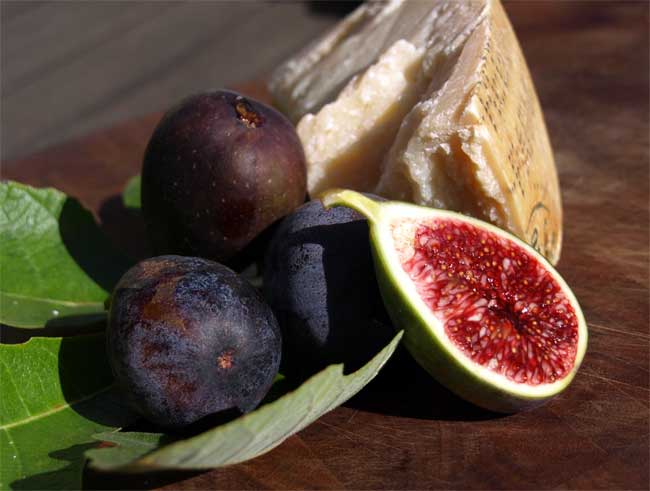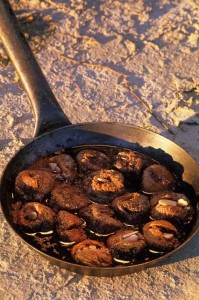My fig tree is covered in a white net that looks like the terylene curtains still favoured as lavatory windows by the caravanning set. Without the net any fruit would have long since been devoured by the ever present hordes of voracious satin bower birds that loiter around my garden like mobs of spivs lasciviously eyeing off my fruit. The allegory here is not lost on me any more than it is on you gentle reader.
I remember my own adolescence and can empathise with the poor birds, the fruit of the fig sliced open not only looks erotic, but it’s flavour is complex, sweet and exotic. To bite into the flesh of a fresh fig is a truly sensual pleasure. To me it is curious that the leaf of this, the sexiest of fruits has also become the tool of censorship and prudity since the time of the renaissance. Curiously, the fruit of the fig is not a fruit at all, but a synconium, which is a fleshy hollow receptacle with multiple ovaries on the inside.
Sadly for the fig, the plant’s sexual activity is confined to giving pleasure to others. They themselves are symbiotic, meaning they can only reproduce with the aid of another creature, in their case the fig wasp, which drills its way into the synconium to reproduce. The female progeny departs on maturity to find another synconium, carrying the pollen with it to fertilise the new host tree.
Originally occurring from Afghanistan to Portugal, humans have nurtured and revered the common fig Ficus carica since antiquity. Fossil remains in Jordan reveal that figs have been cultivated for over 11,000 years. Australian Aboriginal people have been chowing down on the fruit of several species of native figs for over 40,000 years.
Some 34,000 years later than that -according to Genesis 3.7- when Adam and Eve were turfed out of the Garden of Eden “then the eyes of both of them were opened, and they realized they were naked: so they sewed fig leaves together and made themselves aprons”.
And henceforth the sexy fig became unfairly maligned as a symbol of prudity, and one of the great oddities of western art, the “oversized single leaf of dubious botanical provenance we find in Renaissance art”. Cosimo III de’Medici saw nudity as “disgusting” and ordered that fig leaves be painted over the genitalia of Adam and Eve on a fresco painted by Masaccio in 1425. Across Christendom, Protestant preachers such as Luther, Zwingli and Calvin were railing against the sinfulness of human flesh. The Catholic Church, playing catch up, issued an edict at the Council of Trent (1545-1563) that explicitly forbade the depiction of genitals, buttocks and breasts in sacred art. Sound familiar? In Politics it seems nothing has changed in 500 years!
In 1557, fig leaves were instituted by the bull of Pope Paul IV as the accepted device to reduce the amount of nudity on display, and so Raphael, Rubens, Titian, da Vinci and Michelangelo jumped into line and started slapping them on all the good bits.
Sometimes as in Michelangelo’s The Last Judgment, drapery or extra branches from any nearby bush were added; at other times, as on the statue of Mercury that stands in the Vatican, a fig leaf was arbitrarily slapped on the offending appendage.
The fig gets a positive mention in the Qur’an. In the Hadith, Sahih al-Bukhari quotes the Prophet as saying, “If I had to mention a fruit that descended from paradise, I would say this is it because the paradisiacal fruits do not have pits…eat from these fruits for they prevent hemorrhoids, prevent piles and help gout.” Perhaps there’s help for me yet !
Aside from the medicinal benefits of the fig, its culinary contribution is inestimable. It is simply one of my favourite foods. Its versatility is astonishing, it can be put to use in the most simple or complicated ways you can think of. At this time of year it is great to just wander across to the tree, pick a handful of plump ripe black figs and saunter back to the table in the courtyard. (Under the watchful eye of the satin bower birds lurking in the shadows). On a simple wooden board, slice them in half and wrap them in a slice of Toni Marino’s gorgeous prosciutto.
They are delicious with cheese, almost any cheese, or on pizza, with pine nuts, mozzarella, sun dried tomatos and pesto.
My friend Gayle Goldsmith places fig quarters in a baking tray with fresh raspberries from the Jamieson Berry Farm. Over the top she spreads crème fraiche and then sprinkles the lot with a dusting of raw sugar and places the tray under the grill. The result is magnificent. Rich, complex flavours in no time at all.
The master Cheong Liew has a wonderful recipe where dried figs are stuffed with chocolate and chopped almonds, placed in a heavy pan and poached in white port. Rich and luscious, this dish is something else, and so easy. Cheong used to serve this at his 1970’s Adelaide restaurant Neddy’s in old vegemite jars!
Get the recipe here.
But for my money’s worth, I like nothing better than perusing the tree, giving the odd one a little squeeze, checking out the dark skin, looking for a little burst of sweet juice bubbling out, then picking the best and putting it straight in my gob. It is so good it must be a sin. If you have any comments to add, please do so below.
Fortunately I am happy to report that in 1980 during a restoration of the Brancacci Chapel in Florence, the fig leaves were removed from Masaccio’s Adam and Eve, and Adam’s pecker once again leads the way out of paradise.







I agree fresh figs are lucious, fleshy and yes sexy
Makes you wonder why on earth people would then turn them into fig jam.
I couldn’t agree more, especially when the more creative conservator decides to add ginger. Two of my favourite ingredients destroyed! Thanks for your comment.
I just checked the recipe and noticed not to boil the port. I suspect this would mean the full alcoholic value of the port would remain. I reads nice but never having a large supply of figs I would still prefer to eat them unaltered straight from the tree.
Hi Carloyn,
As the port is just below boiling, the alcohol still evaporates, and this recipe is best with dried figs. I, like you LOVE fresh figs. Our problem is the season is so short, my tree only has ripe figs for around two weeks every year. Thank you for your comment, and reading my blog
Cheers
Andrew
Greetings. This is my first time on your blog, but you have a terrific one. I am always on the look out for new blogs, new ideas. I especially appreciate all the details you do, so many photos makes it seem like anyone can replicate the recipe!
I am asking, would you please consider posting a few of your favorite recipes on erecipecards.com
http://erecipecards.com/
It is a tool for bloggers to see and to be seen. Your posts would fit in perfectly.
in addition, all photos, recipe titles as well as your blog name would link directly back to your blog. Thus giving you new attention and potentially new readers.
Or, if you just want to take a look at a lot of fellow food bloggers all in one place. A great learning experience to get ideas about how to establish your own blogging voice!
Please take a look. If you have any ideas or questions, please do not hesitate to write
Dave
http://erecipecards.com/
Contact@eRecipeCards.com